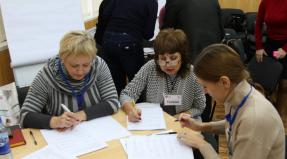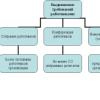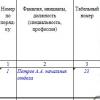Presbyopia (age-related hyperopia). Presbyopia of the eye: diagnosis, signs, treatment and correction Treatment with traditional medicine
If you are over 40, you have probably noticed changes in your vision. In particular, the appearance of presbyopia - a natural age-related process, which consists in the gradual loss of the ability to focus near vision. Learn more about other phenomena and the condition of your eyes after age 40.

What is Presbyopia?
Presbyopia is sometimes referred to as “short arm disease” because, as people get older, they have to move the newspaper farther from their eyes to see the fine print well. Find out why after 40 years of age no one can avoid these annoying vision problems.
Presbyopia usually occurs at the age of 40, when people begin to feel blurry near vision when reading, sewing, or working on a computer. Presbyopia cannot be avoided even if you have had excellent vision throughout your life. Near-sighted people will notice blurred vision at close range when wearing their glasses or contact lenses for the distance.
Without them, myopia is weak and medium will provide good vision at close range. Far-sighted people, on the other hand, are more early age face the problem of blurry near vision, which depends on the degree of hyperopia and the compensatory capacity of the eye for accommodation.
Presbyopia is very widespread throughout the world, especially in Europe, the United States and other developed countries, where the number of middle-aged and older people is constantly growing, which generates a huge demand for glasses, contact lenses and surgeries to solve the problem of blurry near vision.
Symptoms and signs of presbyopia
The problem of blurred vision when working at close range makes people constantly strain their eyes in order to focus and focus their vision properly. Therefore, reading newspapers, writing, a computer, embroidery and other daily activities can lead to headaches, eye fatigue, poor general health - asthenopia.

What Causes Presbyopia?
All changes in your vision due to presbyopia are associated with age-related processes in the structure of the lens of the human eye and the intraocular muscle. Gradually, the lens begins to lose its elasticity and ability to change shape when focusing at close range. This distinguishes presbyopia from other visual impairments such as myopia, hyperopia, and astigmatism, which are both genetic and acquired.
Presbyopia treatment
Reading glasses are the simplest and most common method for correcting presbyopia and only used when working at close range.
Spectacles with bifocal or progressive lenses are a more modern option for spectacle correction of presbyopia. Bifocal glasses have two focuses: the main part of the lens is for distance vision, and its lower part is for close work.
Progressive lenses are analogous to bifocal lenses, but they have an undeniable advantage - a smooth transition between zones without a visible border and allow you to see well at all distances, including medium distances.

If you wear contact lenses, your eye doctor may prescribe reading glasses for you to use without removing the lenses. A more correct option would be the selection of reading glasses, although you can also purchase a ready-made pair.
The modern contact correction industry offers today gas permeable or soft multifocal contact lenses, the principle of which is similar to multifocal glasses. The central and peripheral zones of such lenses are responsible for the clarity of vision at different distances.
Another option for using contact lenses for presbyopia is called monovision. In this case, one eye is corrected for good distance vision, and the other near, and the brain itself chooses the clear image it needs at the moment. It should be noted that not every patient is able to get used to this method of presbyopia correction.
The changes in your eye will last until about 60-65 years old. This means that the degree of presbyopia will change, as a rule, every 5 years, it will increase by 1 diopter. You will need to periodically change glasses or contact lenses for stronger ones.
Surgical treatment for presbyopia
Surgical treatment for presbyopia is also possible and involves several options.
Laser thermokeratoplasty uses radio waves to change the curvature of the cornea in one eye, modulating temporary monovision.

LASIK can also be used to create monovision, but is a permanent way, unlike thermokeratoplasty.
Multifocal LASIK is a new way to correct presbyopia, but it is still in clinical trials. This innovative excimer laser procedure creates different optical zones in the patient's cornea for different distances.
Replacement of transparent lenses is a more radical way to correct age-related hyperopia, but it is associated with a certain operational risk. If the presbyopic age coincides with the occurrence of cataracts, then this method will be the best solution to problems with vision correction. Modern artificial lenses of the IOL can correct not only myopia, hyperopia and astigmatism, but also solve the problem of presbyopia.
Read more about these methods in our article "Correction of Presbyopia"
In recent decades, there has been a tendency to increase average duration life.
Already, more than 2 billion people on our planet are over 60 years old.
On the one hand, this is a positive phenomenon, and it speaks of an improving quality of life.
But on the other hand, due to the large number of elderly people, doctors of all specialties are faced with the problem of prevention and treatment of various age-related changes in the body.
Ophthalmologists are no exception. Doctors of this profile are more likely to meet other pathologies associated with age. One of these common pathologies is presbyopia. In this article, we will take a closer look at the indicated ailment.
What it is?
Presbyopia is a violation of the focus of the eyes on objects at close range. The disease is directly related to natural age-related changes.
And sooner or later it occurs in every person who has crossed the sixty-year line. Some people begin to notice difficulties in reading and handicraft as early as 40 years old.

It is noteworthy that other types of vision are not disturbed: the patient still sees well at medium and long distances. This disorder is often referred to as "short arm disease."
This name came about because usually for normal focusing, a person suffering from presbyopia has to move the subject at least at arm's length.
Brief medical history
Accommodation is the ability of the eye to focus on objects located at different distances. This "adjustment" occurs due to the tension of some muscles and a temporary change in the shape of the lens.
Over time, this ability is lost due to dystrophic changes in the ciliary muscle and the loss of its elasticity by the lens. The lens cannot take the desired shape, and the image is incorrectly projected onto the retina.
After 60 years, the accommodation distance usually decreases to 1 diopter, and the closest point on which the eye can easily focus is at a distance of at least 100 cm.
Prevalence and significance
Presbyopia is the most common ophthalmic pathology caused by the aging of the body. 60% of people over forty suffer from hyperopia. By the age of 60, this figure approaches 100%.
The most common disease in the population Western Europe, United States of America and Japan. This is due to both the high life expectancy in these countries and the large percentage of people involved in skilled labor with heavy loads on the organs of vision.
Men and women suffer from presbyopia equally often, but the disease manifests itself in women at an earlier age.
Presbyopia is a socially significant pathology, since in some cases, without timely correction, it can lead to disability due to other visual impairments.

Risk factors
Despite the fact that presbyopia develops to one degree or another in all people throughout life, some groups of people are most susceptible to the development of this disease:
- people over the age of 40;
- patients with untreated hyperopia and other accommodation disorders in history;
- women;
- people whose daily activities or work are associated with intense eye strain;
- persons with concomitant systemic pathologies (diabetes, myopathy, iron deficiency, vascular and cardiac dysfunction);
- have undergone infectious diseases in severe form (mumps, flu, herpes, measles, meningitis);
- constantly taking certain medications (antidepressants, antipsychotics, anticonvulsants, diuretics);
- people who have undergone various interventions on the eyes (laser microsurgery, vascular photocoagulation) and on the brain;
- residents of hot regions (negative impact ultraviolet radiation and extremely high temperatures);
- malnourished.
Causes

As mentioned above, the main reason for the development of presbyopia is age-related changes in the lens tissue and a decrease in the mobility of the eye muscles.
With age, the lens thickens and takes on an irregular shape, as a result of which it cannot take the required curvature.
It is believed that the maximum capacity for accommodation is observed in adolescence and early adolescence, and after that it begins to decline. Only after 2-3 decades of life, presbyopia becomes so pronounced that it begins to cause discomfort.
Symptoms and diagnostic methods
Presbyopia has the following manifestations:
- headache;
- nausea;
- deterioration in color perception;
- a constant feeling of tension in the eyes;
- Pain in the eyes;
- photophobia;
- the difficulty of viewing objects at close distances;
- inability to read normally and do small handicrafts up close.
To diagnose presbyopia, the doctor first takes a history of the patient. He finds out what ophthalmological diseases the respondent suffers from. His age and the presence of concomitant pathologies are also important.
The results of objective diagnostic studies are no less important. Most often used:
- skiascopy;
- refractometry;
- determination of the volume of accommodation;
- ophthalmoscopy;
- biomicroscopy;
- gonioscopy;
- tonometry;
- ultrasound of the eyeballs;
- computed and magnetic resonance imaging of the brain.
Keep in mind that only a doctor can determine the amount of diagnostic tests required. Do not try to self-diagnose, as it can confuse you even more.
Treatment
Several techniques are used to correct age-related farsightedness.
Medicines and other non-invasive methods
First of all, preference is given to conservative methods of treatment. Patients are prescribed drugs:
- vitamin complexes for the eyes in the form of tablets or drops;
- drops to relieve fatigue;
- moisturizing drops.
Most often, the medical method of treatment does not give sufficient results. In this case, spectacle or lens correction is applied.
This method, if used correctly, is completely harmless, but at the same time very effective.
To correct accommodation disturbances, special lenses are used (the usual ones are not suitable). There are two types of medicated lenses:
- progressive.
It is important not only to choose the right glasses or lenses for treatment, but also for everyday wear. Wearing the wrong glasses and lenses can make your illness worse.
In combination with drug and spectacle correction, physiotherapeutic methods are used:
- massage;
- laser therapy;
- reflexology;
- electrical stimulation;
- training on the device "Trickle".
Surgery

If conservative methods turned out to be powerless, they had to resort to surgical treatment. Of course, it carries certain risks of complications, but at the same time, it can save a person from manifestations of presbyopia forever.
The most common options for surgical correction are:
- laser microsurgery (Lasik and Superlastic);
- keratectomy;
- intraocular interventions (replacement of a natural lens with an implant);
- photoemulsification.
The following video shows how laser vision correction is performed:
Traditional methods
Traditional methods should always be used with caution after consulting a doctor and should not be used as an independent method of treatment.
Alternative medicine offers eye instillation of herbal decoctions:
- eyebright;
- marigold;
- cornflower;
- plantain.
It is also possible to use aloe juice diluted with water as drops for eyes.
Prophylaxis
To prevent presbyopia, you need to follow simple guidelines:
- observe the mode of work and rest;
- reduce visual stress;
- lead healthy image life;
- avoid negative environmental influences;
- treat diseases of the eyes and the whole organism in time.
To keep your eyes healthy for a long time, do not forget to do special exercises:
Forecast
The prognosis for presbyopia is good. This disease usually has a benign course and does not cause serious problems.
Conclusion
- Presbyopia is the loss of the ability to clearly see objects up close.
- Presbyopia is an age-related disorder.
- Most older people suffer from presbyopia.
- For treatment, both conservative and invasive techniques are used.
Video
The following video might come in handy for you:
Presbyopia of the eye is a disease that is directly related to the natural aging process of the human body, few people manage to avoid it, often manifests itself in adults. Presbyopia is a decrease in the accommodative function of the eye due to aging.
The main symptom of the disease: deterioration in the ability to see at a short distance. The patient develops a pronounced blurred vision, concomitant symptoms can also be observed: deterioration in general well-being, chronic fatigue eyes, severe headaches.
When diagnosing pathology, the ophthalmologist checks the patient's vision without fail, carries out the procedure, and evaluates the refraction of the eyes.
In fact, presbyopia of the eyes, or, as it is also called, senile, is an inevitable process. Pathology begins to develop on average in adults aged 40 to 45 years. If a person suffers from farsightedness, the process begins earlier, and if, then later. In both cases, the decrease is progressive, and as a result, the ability of the organ of vision to focus on nearby objects is completely lost. According to ophthalmologists, at least 25% of the population currently suffers from presbyopia.
In the international classification of diseases ICD-10 presbyopia has a code H52.4.
Causes of Presbyopia
The reasons for the development of presbyopia are the natural aging processes of the lens, leading to a weakening of accommodation.
IMPORTANT! Accommodation is the unique ability of the organ of vision to instantly adapt to the vision of objects located in relation to each other at different distances.
The main pathogenic link in lens aging is phakosclerosis, which is characterized by dehydration of the lens and its loss of plasticity. Dystrophic changes are especially active in the ciliary muscle, the main function of which is to hold the lens.
Due to the developing dystrophy, new muscle fibers of the ciliary muscle cease to form, they are replaced by connective tissue. As a result, the contractile ability of the muscle is significantly reduced.
The described process is related to metabolic disorders through the retinal vessels. The disease develops especially rapidly in people suffering from atherosclerosis, hypertension, diabetes mellitus and some other pathologies. Presbyopia can also be caused by professional activity a person if it is associated with increased visual stress at close range. The risk group primarily includes people working at a computer, jewelers, laboratory assistants, engravers, and writers.
Presbyopia in both eyes
Older people most often develop presbyopia in both eyes. It manifests itself in the following alarming symptoms:- it becomes difficult for a person to handle small objects (for example, it is almost impossible to thread a needle);
- in the process of reading, bright light begins to be required;
- to read small text, you need to take it to a relatively distant distance;
- reduced perception of contrast when reading;
- eyes get tired quickly.
Not many people know, but presbyopia in both eyes in people with myopia and farsightedness often manifests itself in different ways. In persons with farsightedness, upon reaching adulthood, vision, both far and near, decreases. In people with myopia, presbyopia may go unnoticed at all. For example, with -1D or -2D vision (mild myopia), the two processes cancel each other out, and the need to purchase reading glasses comes much later. If the myopia is severe, it is likely that the symptoms of presbyopia will not appear at all.
Presbyopia treatment
Before starting treatment for eye presbyopia, the disease must be diagnosed. For this, the following procedures are carried out:- standard test of visual acuity by means of a table;
- (determination of intraocular pressure);
- ophthalmometry (determination of the radii of curvature of the surface of the cornea);
- (study of the refractive power of the eyes).
The described studies allow the optometrist to make a comprehensive assessment of the functionality of the patient's organ of vision. The latter, in case of detection of presbyopia, will be referred for further treatment to an ophthalmologist. Most often, the therapeutic treatment of presbyopia is reduced to spectacle correction or laser (surgical) treatment.
As a rule, patients are prescribed bifocal glasses, the lens of which simultaneously has two focuses - one for near vision, and the other for distance vision.
Some professionals prefer to use progressive lenses. They correct vision for different indicators range. Their main difference is that the difference between the distance and near vision zones cannot be seen with the naked eye. This lens has three main areas:
- upper - for distance vision;
- lower - for near vision;
- intermediate - a kind of progression corridor in which the optical power of the lenses smoothly changes.
Patients suffering from presbyopia are required to be prescribed eye gymnastics, massage of the cervical-collar zone, and (in some cases) reflexology or hydrotherapy.
Surgery
Surgical treatments for presbyopia include refractive surgery. During the operation, the doctor changes the shape of the cornea to the patient.
Currently, several types of refractive surgery are used in medicine:
Keratoplasty
This procedure involves applying radio frequency energy using high temperatures to microscopic spots in the cornea. The main disadvantage this method is not too long period of preservation of the effect. Typically, the problem returns after a very short time.

Laser surgery
Quite a popular treatment method. With the help of a special tool, the doctor makes a thin flap on the cornea of the eye, removes the inner layers, making the shape of the eyeball more round.
Photo refractive surgery
The procedure is very similar to laser surgery. Only the epithelium of the cornea itself is subject to removal.
There is also a more radical treatment for presbyopia. It consists in replacing the lens with an artificial one. In the case of the standard course of the disease, this technique is usually not used. They resort to it in the event that a patient develops such a concomitant disease as.
Correction of presbyopia
The easiest and most affordable way to correct presbyopia is with monofocal glasses. Their selection should be individual. At the initial stages of the development of pathology, experts recommend that patients increase the distance to readable text, increase the light level in the room and rest your eyes more often while working. When the indicated recommendations stop working, doctors prescribe glasses with minimal correction.
There are a number of situations when it is not possible to correct vision with glasses. This is primarily about the following points:
- If a person is unable to use glasses due to professional restrictions (sailors, military men, steel workers, athletes, etc.).
- Wearing glasses is very uncomfortable.
In these cases, instead of glasses can be used. Special lenses for correcting presbyopia appeared at the end of the last century. And at present, the choice of correction methods with their help is quite wide:
Combination of lenses with glasses
Such correction is usually required if presbyopia develops in parallel with or hyperopia. One of the corrective aids is assigned to the far vision and the other to the near.
Monovisual correction
This manipulation consists in the selection of a lens for one eye to work at close range, and on the other - at a distant one.
Correction with bifocal lenses
Such lenses can be of two types:- Bivisual simultaneous. In them, one zone corrects vision at a close distance, and the other - at a distant one. Localization of both zones occurs in the pupil area. Due to this, both images are projected directly onto the retina with a different sharpness index; the choice of perception, in turn, occurs at the sensory level.
- Alternating. In them, the principle of operation is similar to bifocal glasses: there are two zones with different refractive index. The action of the lens in this case is based on its vertical movement and installation in front of the pupil of the required zone.
Correction with multifocal lenses
In such lenses, there is no clear separation between the central and peripheral parts of the optical zone. Thanks to this design, a smooth transition of refraction from one area of view to another is provided. Corrective properties are achieved by changing the radius at different parts of the rear or front surface of the lens.

Prevention of presbyopia
Most pathologies are easier to prevent than to cure. Unfortunately, eye presbyopia is not one of those. Many doctors do not even consider it a disease, claiming that this is a completely natural change in the body associated with aging, which a person cannot stop.
It means that preventive measures, allowing you to completely protect yourself from the development of presbyopia, are absent. But it is quite possible to slow down the development of the disease. Particularly close attention when working in this direction is recommended to be paid to the organization proper nutrition, replenishing the lack of vitamins in the body and regular exercise for the eyes.
The lack of vitamins A, B and C has an especially negative effect on the state of vision. In addition, a lack of zinc, magnesium and copper in the body can accelerate the development of presbyopia.
In the absence of special problems after reaching forty years of age, all people are strongly advised not to neglect regular visits to an ophthalmologist. Timely detection of the problem will allow you to take adequate measures necessary to preserve vision for a longer period of time.
Additionally, you can use one of folk ways prevention of presbyopia. A decoction of cornflower, strawberry flowers, marigolds and plantain is very useful in this regard. It is very simple to prepare the product - the herbs should be mixed in equal proportions (the total volume should be about two tablespoons) and pour 0.5 liters of boiling water. The composition should be drunk three times a day before meals, 70 grams at a time. There are no restrictions on the duration of the drug intake.
No less useful will be the more familiar to all rosehip broth. Plant petals (pre-dried) in the amount of a teaspoon should be poured with 0.5 liters of water and boiled for a couple of minutes over a fire. It is necessary to use the broth twice a day - in the morning and in the evening, half a glass.
If you are not allergic to honey, it can also be used as prophylactic, it is added to any of the above broths in the amount of one table boat and thoroughly mixed until completely dissolved.
Modern medicine successfully corrects progressive presbyopia, therefore, even if the disease was not diagnosed for it initial stage, there should be no reason for panic. The most important thing is not to let the process take its course further and seek help from an experienced ophthalmologist in a good clinic, who will select the most appropriate measures in a particular case.
Presbyopia is a disease that forms against the background of a completely normal process taking place in human body... We are talking about aging, including the lens. The development of such an age-related disease can not be avoided by any person. The main pathogenetic factor is sclerotic changes in the lens. In addition, clinicians identify several reasons that contribute to the early formation of senile hyperopia.
The main clinical manifestation there is a gradual decrease in visual acuity, which consists in the fact that a person cannot see objects or people that are close to him.
Diagnosis of the disease is not difficult, however, to assess the severity of its course, it is necessary to carry out specific ophthalmological tests. Additionally, instrumental examinations of the patient may be required.
V International classification diseases of the tenth revision of presbyopia are given a separate meaning. It follows from this that the ICD-10 code will be N 52.4.
Etiology
Despite the fact that pathology is considered age-related and is inevitable for every person, the exact reasons for its development remain unclear. However, it is known that the basis of pathogenesis is formed by normal processes that occur in the organs of vision and, over time, lead to a weakening of accommodation and are of a physiological nature.
Accommodation is the ability of the organs of vision to adapt to different conditions in order to clearly see objects at different distances. The adequacy of such a process is dictated by the lens, which has the property of changing the power of refraction - it can vary in the degree of distance from which an object is located, as well as the ability to focus the image on the retina.
The main sources of ocular presbyopia are:
- dehydration and sclerotic changes in the lens, which is also called phakosclerosis;
- compaction of its capsule and core;
- decrease in its elasticity;
- a decrease in the adaptive capabilities of other structures of the organs of vision;
- dystrophy of the ciliary muscle of the eyes, which is aimed at holding the lens.
In cases of the formation of such an ailment, the first Clinical signs begin to be expressed at the age of 40 to 45 years, however, under the influence of unfavorable factors, the disease can occur in younger people. This is facilitated by the following reasons:
- diabetes mellitus and other metabolic disorders;
- atherosclerosis;
- astigmatism;
- hypertonic disease;
- hypovitaminosis, namely a deficiency of vitamins B and C;
- chronic intoxication - nicotine or alcoholic;
- hypermetropia;
- frequent exposure of the eyes to inflammatory lesions, in particular conjunctivitis, uveitis, blepharitis and keratitis;
- previous eye surgeries;
- injury to the organs of vision;
- features of professional activity are work associated with constant visual load.
All of the above factors affect the fact that the lens loses the ability to increase the radius of curvature when examining objects located close to the eyes.
Such an age-related pathology is an irreversible condition, however, it progresses differently for each person. For example, in persons suffering from hyperopia, it develops much faster than in other people.
Symptoms
It is not difficult to diagnose presbyopia, because the disease has a rather specific clinical picture characteristic of a certain age group of patients.
The main symptoms of the disease are:
- decreased visual acuity;
- blurring of the picture before the eyes;
- difficulties when considering objects located near a person;
- Difficulty reading and writing
- frequent attacks of headaches;
- rapid fatigue of the organs of vision;
- increased tearing;
- sensitivity to light;
- a feeling of soreness of a dull nature in the eyeballs, which can spread to the bridge of the nose and the brow area;
- a constant desire to move this or that object away from the eyes or turn on a bright light even during daylight hours.
The progression of accommodation is observed up to 65 years of age - over this age it will be equal to zero.
Presbyopia in adults with farsightedness (hyperopia) occurs between about 30 and 35 years of age. It is noteworthy that both near and far vision deteriorates in such persons. It follows from this that such a disease not only provokes the early formation of presbyopia, but also greatly enhances it.
People suffering from myopia (myopia) are distinguished by the fact that such an ailment may be completely unnoticed by them.
Diagnostics
Presbyopia in both eyes is easily diagnosed; nevertheless, for this, the ophthalmologist must prescribe a whole range of diagnostic measures to the patient.
The first step in establishing the correct diagnosis involves the work of the doctor with the patient and includes:
- familiarization with the history of the disease - to search for pathological conditions that may have led to the early onset of pathology;
- collection and analysis of life history - this should include information regarding the patient's age, the presence of injuries or operations on the organs of vision;
- conducting a thorough examination of the eyes using special ophthalmic instruments, as well as assessing visual acuity by conducting specific tests;
- a detailed survey of the patient - to find out the first time of onset and the severity of symptoms.
Instrumental diagnostics of presbyopia is aimed at the implementation of the following procedures:
- automatic refractometry - the study of the ability of the eyes to refract light rays;
- ophthalmometry is the measurement of indicators such as radii of curvature and refractive power of the cornea;
- UZB or A-scan is an ultrasound examination of the organs of vision;
- biomicroscopy of the eye;
- ophthalmoscopy - examination of the fundus;
- computerized keratotopography - aimed at assessing the state of the cornea by exposing it to laser radiation;
- an eye test with a special ophthalmic device called a phoropter;
- skiascopy;
- gonioscopy and tonometry - to exclude the presence of glaucoma, which may accompany ocular presbyopia.
Laboratory studies of human biological fluids in such a situation have no diagnostic value.
Treatment
The neutralization of the disease is carried out by such therapeutic methods:
- optically;
- microsurgically;
- laser.
Often as conservative therapy such events are performed:
- spectacle correction - at the stage of diagnosis, the clinician, if necessary, selects glasses or contact lenses to correct vision deviations.
- the use of medicinal drops and vitamins for the eyes.
Comprehensive treatment for presbyopia will include:
- gymnastic exercises for the eyes - the program is common for all patients;
- undergoing a course of medical massage of the cervical-collar zone;
- physiotherapeutic procedures, namely magnetic laser therapy, reflexology, olektrookulostimulation;
- hydrotherapy;
- training on a simulator such as an accommodation trainer.
Microsurgical therapy involves:
- orthokeratology;
- laser treatment;
- photorefractive keratectomy.
Surgical intervention is aimed at replacing the lens with an artificial intraocular lens, which is:
- monofocal;
- multifocal.
In any case, the IOL is implanted immediately after the phacoemulsification of the cataract.
In addition, it is not prohibited to use funds traditional medicine, but only after consulting your doctor. This method of treatment involves the use of:
- eyebright and cornflower;
- plantain and strawberry flowers;
- marigold and aloe;
- rose hips and nettles;
- motherwort and lingonberry leaves;
- pine needles and flax seeds;
- wheatgrass root and blueberry leaves.
The above medicinal herbs and plants can be used both in pure form and as herbal collection... Medicinal decoctions obtained on their basis can either be taken orally or made into eye drops.
Causes of Presbyopia
Presbyopia is based on natural involutional processes occurring in the organ of vision and leading to a physiological weakening of accommodation. The development of presbyopia is an inevitable age-related process: for example, by the age of 30, the accommodative ability of the eye decreases by half, by the age of 40 - by two-thirds, and by the age of 60 it is almost completely lost.
Accommodation is the ability of the eye to adapt to seeing objects located at different distances. The accommodative mechanism is provided due to the property of the lens to change its refractive power depending on the distance of the object and to focus its image on the retina.
The main pathogenetic link of presbyopia is sclerotic changes in the lens (phakosclerosis), characterized by its dehydration, compaction of the capsule and nucleus, and loss of elasticity. In addition, with age, the adaptive capabilities of other structures of the eye are also lost. In particular, dystrophic changes develop in the ciliary (ciliary) muscle of the eye holding the lens. Dystrophy of the ciliary muscle is expressed by the termination of the formation of new muscle fibers, their replacement connective tissue, which leads to a weakening of its contractile ability.
As a result of these changes, the lens loses its ability to increase the radius of curvature when examining objects close to the eye. With presbyopia, the point of clear vision gradually moves away from the eye, which is manifested by the difficulty of doing any work close to.
Age-related changes in the optical apparatus of the eye are associated with metabolic disorders through the vessels of the retina and conjunctiva and develop faster in people suffering from diabetes mellitus, atherosclerosis, arterial hypertension, hypovitaminosis, chronic intoxication (nicotine, alcoholic). The earlier development of presbyopia is promoted by hyperopia, astigmatism, frequent inflammation of the eyes (conjunctivitis, uveitis, blepharitis, keratitis), eye surgeries, eye injuries, as well as professional activities associated with intense and prolonged visual stress at close range (laboratory assistants, engravers, programmers, etc.). In turn, early-onset presbyopia is a risk factor for the development of glaucoma.
Presbyopia symptoms
People with emmetropia develop the first signs of presbyopia between the ages of 40 and 45. When working at close range (writing, reading, sewing, studying small details), rapid visual fatigue (accommodative asthenopia) occurs: eye fatigue, headaches, dull pain in the eyeballs, bridge of the nose and brows, lacrimation and mild photophobia. With presbyopia, objects located nearby become blurry, indistinct, which is manifested by the desire to move the object of study away from the eyes, to turn on brighter lighting.
Subjective manifestations of presbyopia develop when the closest point of clear vision moves away from the eye by 30-33 cm, that is, on average after 40 years. Changes in accommodation progress up to 65 years of age - approximately at this age, the nearest point of clear vision moves away to the same distance where the further point is. Thus, the accommodation becomes zero.
Presbyopia in hypermetropes (persons with farsightedness) usually manifests itself earlier - at the age of 30-35 years. At the same time, not only near vision, but also far vision deteriorates. Thus, hyperopia not only contributes to the early development of presbyopia, but also exacerbates it.
In people with myopia (myopia), presbyopia may go unnoticed. So, with small degrees of myopia (-1-2 diopters), the age-related loss of accommodation is compensated for a long time, and therefore the manifestations of presbyopia develop later. Persons with myopia -3-5 diopters often do not need near vision correction at all: in this case, they just need to take off their glasses, in which they look into the distance.
If manifestations of presbyopia are detected before the age of 40, a thorough examination by an ophthalmologist is necessary, aimed at identifying hyperopia and immediate, properly organized correction.
Diagnosing presbyopia
When diagnosing presbyopia, age characteristics, asthenopic complaints, as well as objective diagnostic data are taken into account.
To identify and assess presbyopia, visual acuity is checked with a refraction test, refraction (skiascopy, computer refractometry) and accommodation volume are determined, and the study of finding the closest point of clear vision for each eye is performed.
Additionally, with the help of ophthalmoscopy and biomicroscopy, the structures of the eye are examined under magnification. To exclude concomitant glaucoma presbyopia, gonioscopy and tonometry are performed.
During the diagnostic appointment, the ophthalmologist, if necessary, selects glasses or contact lenses to correct presbyopia.
Correction and treatment of presbyopia
Correction of presbyopia can be carried out by optical, microsurgical and laser methods.
Most often resorted to spectacle correction of presbyopia, which is carried out with the help of collective "plus" lenses. In ophthalmology, specially calculated parameters of the strength of glasses are used, which are necessary for the correction of presbyopia at every age. So, for an emmetropic eye at 40 years old, lenses of + 0.75 + 1 diopters are prescribed, then every 5 years, +0.5 diopters are added (that is, at 45 years old, the power of the glasses will be +1.5 diopters; at 50 years +2 diopters; at 55 years old +2.5; at 60 years old + 3 diopters, etc.). As a rule, after 65 years of age, an increase in the correction of presbyopia is not required.
For hyperopes, to calculate the optical power of glasses, the degree of farsightedness must be added to the value of the age correction of presbyopia. To determine lens strength in myopes, subtract the degree of myopia from the age-appropriate presbyopic lens. It should be borne in mind that these data are approximate and necessarily require clarification by directly placing the glasses on the eye.
Taking into account the need, simple glasses are selected for working at close range, complex glasses (bifocal) with two focuses for distance and near vision, progressive, multifocal lenses or other options for optical correction of presbyopia.
In the complex correction of presbyopia, vitamin therapy, gymnastics for the eyes, massage of the cervical-collar zone, magnetic laser therapy, reflexotherapy, hydrotherapy, electro-oculostimulation, and training on an accommodation trainer (the device "Trickle") are used.
Surgery presbyopia can also be variable. In the field of laser surgery, the PresbyLASIK technique is successfully used to correct presbyopia, with the help of which a multifocal surface is formed on the cornea, which makes it possible to obtain both far and near focus on the retina. To other ways laser correction presbyopias include PRK (photorefractive keratectomy), Femto LASIK, LASEK, EPI-LASIK, Super LASIK, etc.
Intraocular correction of presbyopia involves replacing the lens, which has lost its physicochemical properties and elasticity, the ability to accommodate with an artificial intraocular lens (IOL). To correct presbyopia, special accommodating monofocal IOLs or multifocal IOLs are used, which are implanted immediately after cataract phacoemulsification.
What is presbyopia?
Doctors believe that presbyopia is not a disease, but these are normal processes that occur in the human body, while changes cannot be attributed to pathologies, this is a natural process. Treatment may slightly improve the patient's condition, but it is unlikely that it will be possible to completely restore vision.
This process can be slowed down a little, in addition, patients at risk are advised to visit an ophthalmologist as often as possible. Let's take a closer look at the concept of eye presbyopia, what it is and what the consequences can be from this process.
Who is at risk and factors affecting the process of presbyopia
The process can be accompanied by various diseases, and external factors that a person does not pay special attention to can also affect the development of presbyopia. Let's consider them in more detail:
- Old eye conditions such as glaucoma or cataracts.
- The process of loss of vision can begin as a result of diabetes mellitus.
- Genetic predisposition is excreted in people after 45 years.
- Permanent work that requires eye strain or work with small details.
- Diseases of the heart and brain.
- Constant intake of certain medications for various purposes.
- Living in difficult regions with large temperature drops.
- Poor food and inappropriate living conditions.
The process of loss of vision can begin to develop not only in people over 60, but also in adolescents, but such cases are quite rare.
What is Presbyopia?
Presbyopia is a refractive error in the eye that occurs with age. Under the concept of refraction of the eye is meant the violation of refraction of light in the optical system. This entire eye system consists of the following components: cornea, iris, lens, vitreous body.
Light passes through all the components and enters the retina, where further the process of converting light particles into nerve impulses forming images. 
Causes of Presbyopia
Presbyopia is the aging of the lens that occurs naturally with a person's age. Of course, such changes cannot happen abruptly, they appear gradually. The muscles of the eye become weaker, as a result of which the lens begins to bend, as a result, a person begins to lose the ability to focus at different distances.
If you pay attention to the process of loss of vision in time, then it can be stopped. If there is a suspicion that a patient is developing presbyopia, the reasons given by doctors are mainly as follows:

Signs of presbyopia
Recognizing presbyopia is not difficult: a person gradually begins to lose the ability to recognize objects. Most often, people pay attention to the loss of vision when reading, the letters in the book begin to blur, and you can see what is written on the sheet only by moving the book a distance. Vision becomes somewhat blurred, but this can be an individual manifestation.
Presbyopia can be a complication of hyperopia or myopia. At congenital hyperopia vision decreases not only with close reading of a book, but also with a distant one. Patients who suffer from myopia may not initially notice the development of presbyopia.
Presbyopia symptoms
As a rule, patients begin to consult an ophthalmologist when they lose the ability to recognize the outline of a small object near it. When they begin to move it away from the eyes, then it takes on its shape, and you can recognize the object in question. Problems can also arise in bright light, clarity of vision is lost due to constriction of the pupil and focus occurs in the depths of the eyeball.
A person may complain of blurred vision when looking from one point to another. Additionally, the following symptoms can be distinguished:
- Frequent headaches.
- Discomfort in the eye area.
- Strabismus development.
- Split eyes.
Complications and consequences of presbyopia
Despite the fact that the process of presbyopia manifests itself in old age, it causes many problems for a person and prevents him from leading a full life. In order to identify the main cause of vision loss in time, you should seek help from doctors who will diagnose and prescribe the correct treatment, otherwise complications may begin to develop:

Diagnosing presbyopia
If there is a suspicion that a person is developing presbyopia, treatment, causes, symptoms are the most important thing that needs to be paid attention to. An experienced ophthalmologist will first of all prescribe the following types of diagnostics:


- Ophthalmometry is considered a more complex method, when the radii of curvature and the acting force are measured.
- Ultrasound biometry is performed using an ultrasound examination. Using this method, you can study the anterior chamber of the eye, as well as examine the iris in more detail and even determine the axes of the eyeballs.
- Biomicroscopy of the eye allows the ophthalmologist to get a more complete picture of the disease. For this, a special ophthalmological microscope and a lighting device are used.
- You can check your eyesight on a photoprete - this is a special device for diagnostics. Through it, the patient looks at the tables located at different distances.
- Computerized keratotopography helps to examine the cornea using laser beams.
- Ophthalmoscopy examines the fundus of the eye using a special apparatus. This method makes it possible to examine the state of the retina and optic nerve and also to study the vessels of the fundus.
- When presbyopia is suspected, diagnosis and treatment may involve fitting lenses, as each eye may require a different degree of refraction.
Presbyopia treatment
To correct vision, the doctor prescribes lenses or glasses to the patient. If there were no problems before, then reading glasses are prescribed. Also, if there is presbyopia in both eyes, treatment, exercises for the eyes together will help to restore vision not fully, but will definitely improve it, for this, doctors are developing whole complexes of gymnastics for the eyes.
If there is no improvement, the patient undergoes an operation. Surgical treatment can be laser, in which the cornea is reshaped using an optical beam. Also, with the help of surgical intervention, implantation is carried out artificial lens... It is also important to remember about proper fortified nutrition.
Prevention of presbyopia
Having figured out exactly how presbyopia affects a person's life, what it is, it is worth carefully studying the recommendations for prevention:

As you can see, if you are attentive to your health and promptly seek help from qualified specialists, then vision problems will not arise. Moreover, you should not be afraid of visiting an ophthalmologist, because presbyopia is not a disease, but a natural aging process of a person, as a result of which vision deteriorates.
The aging process of the body is inevitable, and the eyes are no exception. Visual impairment near age is called presbyopia or age-related hyperopia; this article will help you understand what it is, how to recognize it and how to cure it.
Folk remedies
From folk remedies presbyopia reacts to treatment with decoctions of herbs and fees (if you do not understand them, it is better to purchase them at the pharmacy), rose hips, the use of lingonberry juice, blueberry jam, and a sufficient amount of carrots in the diet.
Our grandmothers treated their eyes with a boiled egg, wrapping it in a handkerchief, drove them around their eyes with an eight with sentences and conspiracies, and when the egg cooled to an acceptable temperature, they left it on eyeball for 10 minutes.
Folk remedies for senile hyperopia are good because you do not need to go to a pharmacy or a hospital for them, and all the treatment is done with improvised natural materials. But in fact, these are the same techniques from modern medicine, veiled under home life, products and decoctions contain vitamins, trace elements, as in drops, but in an inaccurate and incomprehensible dosage, and a boiled egg is a massage with elements of physiotherapy and warming up.
Prophylaxis
With the help of prevention, alas, it will not be possible to avoid the development of age-related hyperopia, but it is possible to delay and reduce the severity. Avoid prolonged eye strain, use adequate lighting and posture for reading, viewing monitors, tablets. Do eye gymnastics regularly, eat right, do not prescribe glasses yourself.
Visit an ophthalmologist for an examination at least once a year, because hyperopia does not always manifest itself at first, only a doctor can see and correct this.
We invite you to watch an educational video from Elena Malysheva and Dr. Konovalov about age-related hyperopia. In it you will clearly see what it is and in what ways senile:
Exercise your eyes against presbyopia every day with us. I wish you health, share your impressions and experiences with other subscribers in the comments.



















